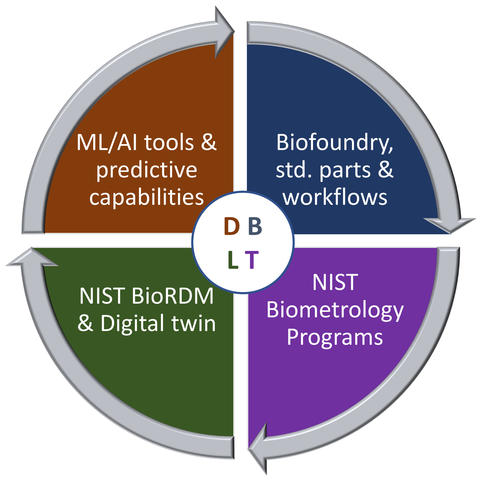Engineering Biology
SUMMARY
Engineering biology (also known as synthetic biology) is the convergence of many disciplines to enable predictive engineering of living systems, the constituent components of living systems, and related biological processes for public benefit, such as curative advanced therapies, advanced material manufacturing, renewable energy sources, more resilient crops, and unprecedented data storage solutions.
The process to engineer biological systems is rapidly transitioning from a costly, laborious, trial-and-error approach to an automated, Design–Build-Test–Learn (DBTL) approach. The NIST Engineering Biology Program supports the growing industry and the research enterprise through advanced measurement solutions, technologies, data, standards, and associated infrastructures to enable predictive engineering and subsequent manufacturing and translation of emerging technologies in support of the bioeconomy.
DESCRIPTION

This program focuses on biometrology, technologies, and standards to promote engineering biology and related innovations and translation. Our efforts in microbial systems aim to deliver measurements and workflows for prediction, control, and design. Our efforts in mammalian systems focus on the development of robust engineering tools, cell lines, and measurements. This program complements BBD’s other programmatic priorities, such as Advanced Therapies, Microbiome, and the Genome Editing Consortium.
Design-Build-Test-Learn Cycle
A focus for the NIST Engineering Biology Program is to enable predictive engineering of biological systems. For example, the NIST Living Measurement Systems Foundry (LMSF), which was fully operationalized in 2019, was designed as a platform to develop and integrate technologies, collect large high-quality data sets, and ultimately provide tools for rapid and predictive engineering. Specifically, the NIST LMSF uses automation for the large-scale growth, manipulation, sample preparation, and measurement of engineered microbes. This capability is currently used to design and optimize living measurement systems via directed evolution and high throughput screening and selection, integrated with ML/AI and modeling. Similar approaches are being used to facilitate the development of robust measurement systems for mammalian cell-based biological assays.
Biometrology and Engineering Biology Capabilities
We leverage BBD core capabilities to address specific measurement challenges associated with engineering biology. The current portfolio is designed to advance integration of measurement systems into engineering pipelines, improve predictability for design stages, ensure comparability of data within and between research laboratories, and enable scalability for practical applications of synthetic biology.
Standards Development
We lead and contribute to various foundational standards to promote engineering biology and the broader biotechnologies.
- Overview of standards development principles
- Documentary standards and reference materials in support of engineering biology
- NIST Synthetic Biology Standards Consortium (SBSC)
Stakeholder Engagement
- NSCT Interagency Working Group on Synthetic Biology (SynBio IWG)
- Engineering Biology Research Consortium (EBRC)
- Global Biofoundry Alliance (GBA)
- BioMADE
- BioFabUSA
- NIIMBL
- Build-A-Cell
FACILITIES
Living Measurement Systems Foundry
Prototype Cell Assay Measurement Platform
Contacts
PRINCIPAL CONTACT
-
(301) 975-6765
NIST STAFF
-
(301) 975-2525
-
(301) 975-8551
-
(301) 975-3646

